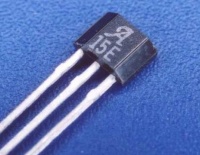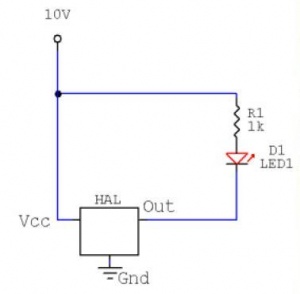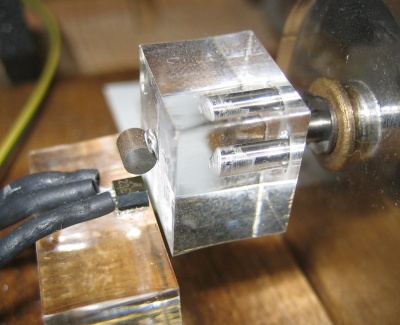Hall Effect Sensor
A Hall effect sensor varies its output in response to a change in magnetic field. They are primarily used for proximity sensing and position/rotation sensing. By placing a hall effect sensor near a magnet attached to your device that moves in some way, you can get a voltage proportional to the distance/orientation of the magnet. One commonly used configuration is placing the sensor directly above a dipole magnet attached to a rotating joint or shaft. The sensor (with some circuitry) will return an analog voltage proportional to the angle of the joint or shaft.
How It Works
As you can tell from the name, the Hall Effect Sensor takes advantage of the phenomenon known as the Hall Effect. The Hall Effect refers to the potential difference (Hall voltage) on opposite sides of a thin sheet of conducting or semiconducting material through which an electric current is flowing, created by a magnetic field applied perpendicular to the Hall element. The equation associated with this is
Circuitry
Hall sensors come in small IC packages and usually have three pins. The inside is simplified in the diagram below:
Applications
A Switch
The following circuit shows how a hall effect sensor can be used as a switch. The LED will light up when the sensor detects a change in the magnetic field.
Detecting a Nearby Ferrous Object
You can use a hall-effect sensor to detect a nearby metal object. An example of how to assembly such a sensor is shown below:
A small magnet is placed next to the hall effect sensor. Normally, the magnetic fields are uniform, but as a metal object approaches, they are changed. The hall sensor picks up on this change and outputs a voltage.
Angle Sensing
By mounting a bipolar magnet on a shaft and placing a hall sensor near it, you can use the hall sensor to measure the angle of rotation of the shaft. The setup below was used in the "haptic paddle" project. The small magnet is attached to the shaft and the small hall sensor is just below it.
References
- Wikipedia, "Hall Effect", http://en.wikipedia.org/wiki/Hall_effect
- Wikipedia, "Hall Effect Sensor", http://en.wikipedia.org/wiki/Hall_effect_sensor
- Honeywell, "Hall Effect Sensors", http://www.honeywell-sensor.com.cn/prodinfo/magnetic_position/technical/chapter2.pdf
- Quasdorf, Joachim, "A Case Study: MR vs. Hall Effect for Position Sensing," http://www.sensorsmag.com/sensors/article/articleDetail.jsp?id=314520, Nov., 2005.






